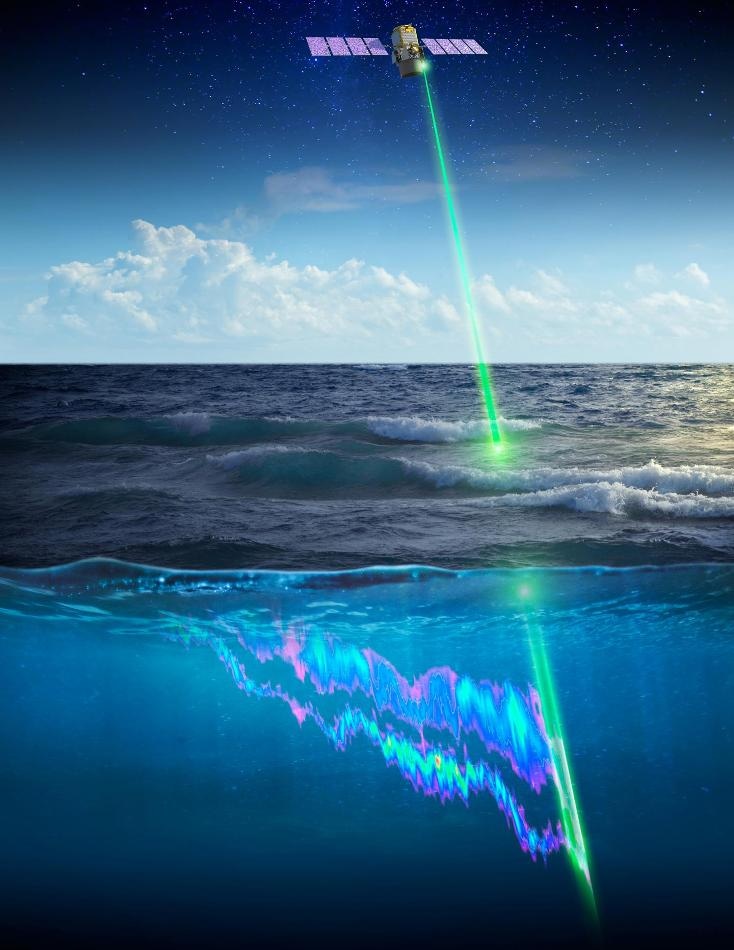Dec 20 2016
Scientists succeeded in getting their first continuous look at the boom-bust cycles that drive polar plankton communities by using a space-based sensor capable of seeing through darkness, clouds and fog.
 An artist's rendering shows a laser beam from a satellite-mounted LIDAR instrument probing the plankton-rich waters of Earth's northern and southern oceans. Credit: Image by Tim Marvel, NASA
An artist's rendering shows a laser beam from a satellite-mounted LIDAR instrument probing the plankton-rich waters of Earth's northern and southern oceans. Credit: Image by Tim Marvel, NASA
According to a study published recently in the journal Nature Geoscience, the decade-long set of images reveals that phytoplankton cycles are further tied to the push-pull relationship between them and their predators than was primarily thought.
Phytoplankton are the basis of the ocean's food web. Michael Behrenfeld, the study's lead author and an expert in marine plankton at Oregon State University's College of Agricultural Sciences, stated that birds, marine mammals and commercial fisheries all depend on the blooms.
It's really important for us to understand what controls these boom-bust cycles and how they might change in the future because the dynamics of plankton communities have implications for all the other organisms throughout the web.
Michael Behrenfeld, lead author
Earth's carbon cycle is influenced by phytoplankton. Through photosynthesis, phytoplankton absorbs a major amount of the carbon dioxide present near the surface of the ocean. This results in allowing carbon dioxide from the atmosphere to go into the ocean.
A laser beam to map the surface of the ocean and immediate subsurface is used by the satellite-mounted LIDAR instrument, dubbed Cloud-Aerosol Lidar with Orthogonal Polarization (CALIOP). From 2006 to 2015, plankton in the Antarctic and Arctic ocean waters was monitored by CALIOP.
Measurements taken by CALIOP reveal the capability of the blooms to outpace the organisms that prey on them as the phytoplankton growth accelerates. The predatory organisms catch up and the bloom ends when this acceleration stops.
Imagine two rubber balls, one green and one red, connected by a rubber band, Behrenfeld stated.
Take the green ball--which represents the phytoplankton--and whack it with a paddle. As long as that green ball accelerates, the rubber band will stretch, and the red ball--which represents all the things that eat or kill the phytoplankton--won't catch up with the green ball. But as soon as the green ball stops accelerating, the tension in the rubber band will pull that red ball up to it, and the red ball catches up.
Michael Behrenfeld, lead author
Behrenfeld stated that this finding goes against the common assumption that blooms start when phytoplankton growth rates reach a threshold rate, and then when the growth rates crash the blooms stop.
Blooms instead begin when growth rates are majorly slow, and then stop when phytoplankton growth reaches its maximum but the acceleration of the bloom hits its peak. It is only at this point that the predatory organisms catch up and the bloom ends.
The study further reveals that the year-to-year changes in this continuous push and pull between predator and prey has been the key driver of change over the past decade in Arctic waters. In the southern ocean surrounding Antarctica, where changes in the ice cover held more sway, the situation seems to be different.
"The take-home message," Behrenfeld said, "is that, if we want to understand the production of the polar systems as a whole, we have to focus both on changes in ice cover and changes in the ecosystems that regulate this delicate balance between predators and prey."
Behrenfeld stated that the capabilities of space-based LIDAR make more room for more-detailed measurements of plankton communities. For instance, the CALIOP instrument, considered to be as good as it is, was engineered in order to take measurements of the atmosphere and does not comprise of the resolution required for capturing detailed information below the surface of the ocean.
NASA is currently developing a higher-resolution instrument that is yet to be deployed on a satellite. This instrument could be capable of gathering subsurface samples at finely spaced depths as the laser pulse passes through the water column, thus allowing scientists to view the vertical structure of plankton blooms. This will indeed reveal a lot about how plankton are influenced by the currents of the ocean and its physical properties, Behrenfeld stated.
This new instrument will also help determining what fraction of the signal is from scattering of light versus the absorption of light.
We can use the scattering information to quantify the concentration of the plankton, and we can use the absorption to say something about the plankton's physiology--in other words, the health of the cells.
Michael Behrenfeld, lead author
The CALIOP sensor is placed on the Cloud-Aerosol Lidar and Infrared Pathfinder Satellite Observation (CALIPSO) satellite, jointly owned by France's space agency and NASA. Other participating institutions include the University of California, University of Maine and Princeton University.